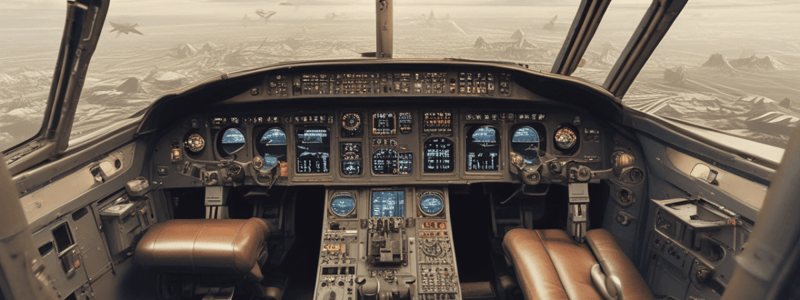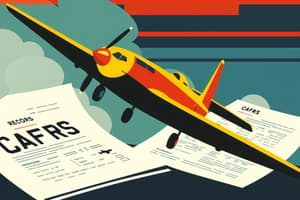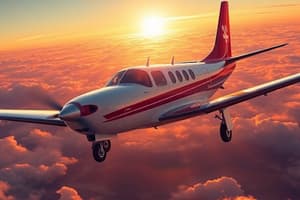Podcast
Questions and Answers
What is a crucial step in the process of importing an aircraft into the U.S.?
What is a crucial step in the process of importing an aircraft into the U.S.?
- De-registering the aircraft from the foreign country of origin (correct)
- Obtaining an Export Certificate of Airworthiness from the FAA
- Conducting a pre-purchase inspection of the aircraft
- Providing evidence of ownership, such as a bill of sale
What is a potential consequence of failure to comply with FAA registration requirements?
What is a potential consequence of failure to comply with FAA registration requirements?
- A delay in the aircraft's maintenance schedule
- An increase in insurance premiums
- A decrease in the aircraft's value
- Operational delays and legal issues (correct)
What type of documentation may be required depending on the aircraft's history and condition?
What type of documentation may be required depending on the aircraft's history and condition?
- Additional inspections or documentation (correct)
- A pilot's logbook
- A bill of sale
- A maintenance log
Which of the following is a key takeaway from the case studies?
Which of the following is a key takeaway from the case studies?
What is a critical aspect of aircraft ownership and registration?
What is a critical aspect of aircraft ownership and registration?
Why is it essential to comply with both the exportation requirements of the country of origin and the registration requirements of the FAA?
Why is it essential to comply with both the exportation requirements of the country of origin and the registration requirements of the FAA?
What is a potential consequence of compromised safety in an aircraft?
What is a potential consequence of compromised safety in an aircraft?
What should an aircraft owner ensure they are familiar with to keep their aircraft compliant and ready to fly?
What should an aircraft owner ensure they are familiar with to keep their aircraft compliant and ready to fly?
What is a necessary step in the process of legally operating an aircraft in U.S. airspace?
What is a necessary step in the process of legally operating an aircraft in U.S. airspace?
What is the purpose of providing evidence of ownership, such as a bill of sale, during the registration process?
What is the purpose of providing evidence of ownership, such as a bill of sale, during the registration process?
Obtaining an Export Certificate of Airworthiness is only required for aircraft manufactured in the United States.
Obtaining an Export Certificate of Airworthiness is only required for aircraft manufactured in the United States.
The FAA's registration process does not require providing evidence of ownership, such as a bill of sale, for all types of aircraft.
The FAA's registration process does not require providing evidence of ownership, such as a bill of sale, for all types of aircraft.
Maintaining proper documentation is only important for ensuring legal compliance, but not for safety reasons.
Maintaining proper documentation is only important for ensuring legal compliance, but not for safety reasons.
An aircraft can be legally operated in U.S. airspace without de-registering from the foreign country of origin.
An aircraft can be legally operated in U.S. airspace without de-registering from the foreign country of origin.
The FAA's documentation requirements only apply to commercial aircraft, not to private aircraft.
The FAA's documentation requirements only apply to commercial aircraft, not to private aircraft.
Aircraft owners are only required to comply with the exportation requirements of the country of origin, not the registration requirements of the FAA.
Aircraft owners are only required to comply with the exportation requirements of the country of origin, not the registration requirements of the FAA.
The registration process includes additional inspections or documentation only for aircraft with a history of accidents.
The registration process includes additional inspections or documentation only for aircraft with a history of accidents.
Operational delays are a minor consequence of failure to comply with FAA registration requirements.
Operational delays are a minor consequence of failure to comply with FAA registration requirements.
An aircraft owner can self-certify their aircraft as airworthy without involving the FAA.
An aircraft owner can self-certify their aircraft as airworthy without involving the FAA.
The FAA's registration process is only applicable to aircraft manufactured in the United States.
The FAA's registration process is only applicable to aircraft manufactured in the United States.
What specific documentation must be obtained before an aircraft can be legally operated in U.S. airspace, and what is its purpose?
What specific documentation must be obtained before an aircraft can be legally operated in U.S. airspace, and what is its purpose?
Why is it crucial to comply with both the exportation requirements of the country of origin and the registration requirements of the FAA during the aircraft importation process?
Why is it crucial to comply with both the exportation requirements of the country of origin and the registration requirements of the FAA during the aircraft importation process?
What type of evidence is typically required to demonstrate ownership during the FAA registration process, and what is its purpose?
What type of evidence is typically required to demonstrate ownership during the FAA registration process, and what is its purpose?
What potential consequences can result from failure to maintain proper documentation during the aircraft ownership and registration process?
What potential consequences can result from failure to maintain proper documentation during the aircraft ownership and registration process?
What is the ultimate goal of complying with the FAA's registration process and maintaining proper documentation?
What is the ultimate goal of complying with the FAA's registration process and maintaining proper documentation?
Why is de-registration from the foreign country of origin necessary before an aircraft can be legally operated in U.S. airspace?
Why is de-registration from the foreign country of origin necessary before an aircraft can be legally operated in U.S. airspace?
What type of inspections or documentation may be required for an aircraft with a complex history or condition during the registration process?
What type of inspections or documentation may be required for an aircraft with a complex history or condition during the registration process?
What is the significance of understanding the FAA's documentation requirements for aircraft owners?
What is the significance of understanding the FAA's documentation requirements for aircraft owners?
Why is it critical to follow established processes for aircraft ownership and registration?
Why is it critical to follow established processes for aircraft ownership and registration?
What is the relationship between proper documentation and aircraft safety?
What is the relationship between proper documentation and aircraft safety?
Flashcards are hidden until you start studying
Study Notes
Aircraft Documentation and Registration
- The Airplane Flight Manual (AFM) and Pilot's Operating Handbook (POH) are cornerstone documents for pilots and aircraft owners, providing essential information for safe and efficient operation of an aircraft.
- The AFM is a unique, serial-number specific document prepared by the aircraft manufacturer and approved by the FAA, containing operational information mandatory for safe operation.
- The POH is a more general document, providing similar information, but not necessarily specific to a single aircraft, and serving as an operational guidebook.
AFM Components
- Specifications
- Limitations
- Handling
- Operational data
- Emergency procedures
POH Components
- Flight planning
- Performance data
- Weight and balance
- Pre-flight checklists
Aircraft Registration
- The FAA mandates that all civil aircraft in the U.S. undergo a standard registration process, which contributes to national security and ownership validation.
- Registration requires:
- Filling out an Application for Aircraft Registration (FAA form AC 8050-1)
- Providing key information like aircraft make, model, and serial number, and proof of ownership (e.g., bill of sale)
- Registration can be done online or at FAA offices
Registration Timing and Renewal
- There is a short-lived grace period for operating an unregistered aircraft
- Registration expires and requires timely renewal to maintain legal compliance and airworthiness
- Failure to comply can result in penalties, fines, or aircraft grounding
N-Number Reservation System
- The N-Number is a unique identifier for each aircraft, similar to a social security number
- It is essential to secure and maintain the N-Number to keep the aircraft legally airworthy
Complex Ownership Scenarios
- Trusts or partnerships involved in ownership require specific additional requirements
- It is essential to navigate these nuances to maintain legal compliance
Case Study 1: The Forgotten Airworthiness Certificate
- Always verify that all required documents, especially the Airworthiness Certificate, are aboard the aircraft before flight
- The Airworthiness Certificate is part of the critical documents list, including the Registration Certificate, Owner's Manual, and Weight and Balance information
Case Study 2: The Ownership Quandary
- Ownership information is accessible through the FAA's Civil Aviation Registry
- Update the registry promptly after a change of ownership to maintain legal compliance and airworthiness
Case Study 3: The Cross-Border Registration Challenge
- When importing an aircraft, comply with both the exportation requirements of the country of origin and the registration requirements of the FAA
- The registration process includes providing evidence of ownership, such as a bill of sale, and may require additional inspections or documentation depending on the aircraft's history and condition
Aircraft Documentation and Registration
- The Airplane Flight Manual (AFM) and Pilot's Operating Handbook (POH) are crucial for aircraft safety and efficiency, and understanding their contents can make a difference in emergency situations.
- The specifications section in the manuals is essential for assessing the airworthiness of parts, and staying up-to-date with regulations is vital for remaining compliant.
- Aircraft registration is a critical aspect of aviation, ensuring the legality of aircraft operation and validation of ownership.
- The Federal Aviation Administration (FAA) mandates that all civil aircraft in the U.S. undergo a standard registration process.
- The registration process involves filling out an Application for Aircraft Registration (FAA form AC 8050-1) and providing key information like the aircraft's make, model, and serial number, and proof of ownership.
- Registration can be done online or at FAA offices, and timely filing is crucial to avoid penalties.
- The registration certificate expires and requires timely renewal to maintain legal compliance.
N-Number Reservation System
- The N-Number Reservation System assigns a unique identifier to each aircraft, similar to a social security number.
- Securing and maintaining the N-Number is essential to identify the aircraft and maintain its legal status.
Aircraft Registration Complexity
- Matters can get complex with trusts or partnerships involved in ownership, requiring additional requirements and nuances to navigate.
- Failure to comply with registration requirements can result in fines, aircraft grounding, and legal issues.
Case Studies
Case Study 1: The Forgotten Airworthiness Certificate
- A pilot neglected to ensure the Airworthiness Certificate was on board, leading to a temporary grounding of the aircraft.
- Key takeaways: Verify all required documents, especially the Airworthiness Certificate, are aboard the aircraft before flight, and understand that the Airworthiness Certificate is part of the critical documents list.
Case Study 2: The Ownership Quandary
- A family faced uncertainty in locating ownership documents and transferring them after the death of an aircraft owner.
- Key takeaways: Ownership information is accessible through the FAA's Civil Aviation Registry, and it's essential to update the registry promptly after a change of ownership to maintain legal compliance and airworthiness.
Case Study 3: The Cross-Border Registration Challenge
- An entrepreneur encountered challenges when importing an aircraft from a foreign seller, requiring a detailed understanding of the FAA's registration process.
- Key takeaways: Comply with exportation requirements of the country of origin and registration requirements of the FAA, and provide evidence of ownership, such as a bill of sale, and additional inspections or documentation depending on the aircraft's history and condition.
Importance of Proper Documentation
- Failure to maintain proper documentation and understand registration procedures can lead to operational delays, legal issues, and compromised safety.
- Ensuring familiarity with the FAA's documentation requirements and following established processes is crucial to keep an aircraft compliant and ready to fly.
Aircraft Documentation and Registration
- The Airplane Flight Manual (AFM) and Pilot's Operating Handbook (POH) are crucial for aircraft safety and efficiency, and understanding their contents can make a difference in emergency situations.
- The specifications section in the manuals is essential for assessing the airworthiness of parts, and staying up-to-date with regulations is vital for remaining compliant.
- Aircraft registration is a critical aspect of aviation, ensuring the legality of aircraft operation and validation of ownership.
- The Federal Aviation Administration (FAA) mandates that all civil aircraft in the U.S. undergo a standard registration process.
- The registration process involves filling out an Application for Aircraft Registration (FAA form AC 8050-1) and providing key information like the aircraft's make, model, and serial number, and proof of ownership.
- Registration can be done online or at FAA offices, and timely filing is crucial to avoid penalties.
- The registration certificate expires and requires timely renewal to maintain legal compliance.
N-Number Reservation System
- The N-Number Reservation System assigns a unique identifier to each aircraft, similar to a social security number.
- Securing and maintaining the N-Number is essential to identify the aircraft and maintain its legal status.
Aircraft Registration Complexity
- Matters can get complex with trusts or partnerships involved in ownership, requiring additional requirements and nuances to navigate.
- Failure to comply with registration requirements can result in fines, aircraft grounding, and legal issues.
Case Studies
Case Study 1: The Forgotten Airworthiness Certificate
- A pilot neglected to ensure the Airworthiness Certificate was on board, leading to a temporary grounding of the aircraft.
- Key takeaways: Verify all required documents, especially the Airworthiness Certificate, are aboard the aircraft before flight, and understand that the Airworthiness Certificate is part of the critical documents list.
Case Study 2: The Ownership Quandary
- A family faced uncertainty in locating ownership documents and transferring them after the death of an aircraft owner.
- Key takeaways: Ownership information is accessible through the FAA's Civil Aviation Registry, and it's essential to update the registry promptly after a change of ownership to maintain legal compliance and airworthiness.
Case Study 3: The Cross-Border Registration Challenge
- An entrepreneur encountered challenges when importing an aircraft from a foreign seller, requiring a detailed understanding of the FAA's registration process.
- Key takeaways: Comply with exportation requirements of the country of origin and registration requirements of the FAA, and provide evidence of ownership, such as a bill of sale, and additional inspections or documentation depending on the aircraft's history and condition.
Importance of Proper Documentation
- Failure to maintain proper documentation and understand registration procedures can lead to operational delays, legal issues, and compromised safety.
- Ensuring familiarity with the FAA's documentation requirements and following established processes is crucial to keep an aircraft compliant and ready to fly.
Studying That Suits You
Use AI to generate personalized quizzes and flashcards to suit your learning preferences.




